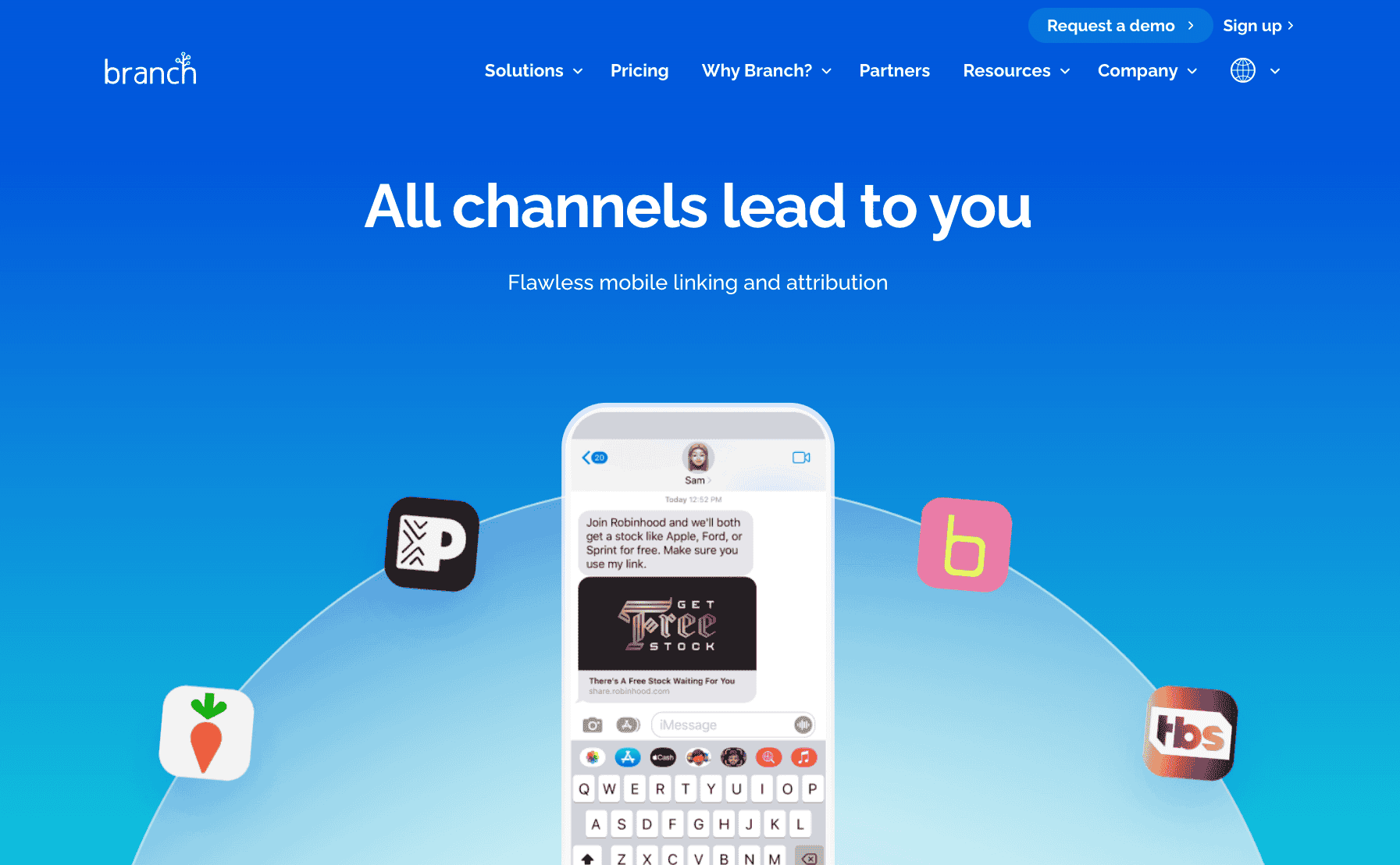Branch.io: Maximizing Mobile Growth and User Engagement
Struggling with user retention? See how Branch.io’s smart linking tech can turn installs into loyal advocates.

Your deep link to sustainable mobile growth—beyond installs and into real ROI
There’s a slide doing the rounds in mobile growth decks that says: “Users don’t download apps. They solve problems.” Cute. True. Also slightly annoying when your KPI dashboard looks like a bloodbath because your shiny new app can’t retain users past Day 3.

In 2025, cracking mobile growth isn’t about brute-force UA spend or “spray and pray” push notifications. It’s about stitching together fragmented user journeys—across devices, platforms, and channels—into one smooth, revenue-happy funnel. This is where Branch.io enters, not with magic beans, but with boring, brilliant infrastructure. Deep links. Attribution. Journeys. The stuff that makes “growth” more than just a dashboard metric.
Let’s break down how Branch quietly powers the mobile big leagues—and how we’ve used it (with more jugaad than we'd like to admit) at 1985 to help apps punch above their weight.
The Myth of the ‘Install’
Why growth isn’t about acquisition anymore—and never really was
Once upon a time, we all high-fived when the install counter ticked up. Today, it’s a vanity metric unless you can:
- Attribute it back to where and why the user came in.
- Predict what they’ll do next and help them do it faster.

Without context and continuity, that install is just another one-night stand. Here’s where most mobile stacks fall apart:
- A user clicks a referral link on WhatsApp, but lands on the App Store with zero context.
- Someone taps a CTA in a push notification and ends up on the app home screen instead of the offer they were promised.
- A paid campaign drives app installs, but 30% of those are duplicates from existing users (hello wasted spend).
Branch’s universal deep links and deferred deep linking solve exactly this. They ensure that when a user interacts with your brand—whether it’s via SMS, email, ads, or QR codes—they land precisely where they’re supposed to, even if they don’t have the app installed yet. Context stays sticky.
Think of it as Google Maps for user intent. You don’t just drop them at the city gate—you navigate them to the exact aisle in the supermarket.

From Deep Linking to Deep Loyalty
How Branch turns anonymous clicks into engaged users
At 1985, we once worked with a fintech app that had insane CAC-to-LTV imbalance. People would install the app, poke around, maybe KYC, and then ghost. No amount of onboarding nudges helped. So we went upstream: What if the user’s entry point could carry context into the app?
Here’s what worked:
- We replaced generic Play Store links in email campaigns with Branch links that routed users to personalised dashboards post-install.
- We used Branch’s “Journeys” (smart banners) to convert mobile web users into app users with continuity. If they were on the loan calculator on mobile web, the app opened straight to that screen.
- We turned every WhatsApp referral into a magic invite—where the link carried user-specific referral codes and opened the app to the exact onboarding flow with the reward pre-loaded.
The result? A 38% jump in Day 1 activation. And a 2x improvement in referral-to-conversion rates.
It wasn’t wizardry. It was context.

Attribution Wars: Who Gets the Credit?
Branch vs MMPs, the Apple problem, and why you still need receipts
Let’s address the elephant in the SDK room: mobile attribution is a mess. Between Apple’s ATT (App Tracking Transparency), limited IDFA access, and Android’s Privacy Sandbox, knowing where your users come from has become a probabilistic headache.
Enter Branch’s attribution engine.
Unlike traditional MMPs (Mobile Measurement Partners) that rely heavily on device identifiers, Branch uses deterministic and probabilistic methods, stitching together touchpoints across:
- Email opens and clicks
- Web-to-app transitions
- QR code scans
- Paid ads (even with limited IDFA)
We once audited a client using a popular MMP that showed 60% of installs as “organic”. When we switched on Branch tracking (alongside consented user flows), we saw 40% of those “organic” installs actually originated from influencer-led WhatsApp shares and organic YouTube reviews. That insight completely reshaped their growth strategy and budget allocation.
No shade on MMPs—but if you’re running serious web-to-app or influencer-led plays, you want Branch in your corner.

5 Branch.io Plays That Actually Move the Needle
Cheat sheet from the trenches
Here are the most effective Branch-powered plays we’ve run (or seen run) that delivered real business impact:
1. Referral programs that actually track
Use Branch links for invites and rewards. They work across iOS/Android, mobile/web, app installed/not installed. And yes, you can still pass UTM parameters cleanly into the install journey.
2. Email-to-app resurrection
Send inactive users a reactivation email with a Branch link that takes them to a re-onboarding screen or a special promo inside the app. It’s like time travel for churned users.
3. Smart banners that convert
Branch’s “Journeys” banners on mobile web convert up to 2–6x better than generic “Download Our App” prompts. Plus, you can A/B test them like a growth nerd.
4. Influencer and UGC tracking
Give each influencer a Branch-powered QR code or link. You'll finally be able to track true ROI per creator (and filter out the vanity ones).
5. Offline-to-app campaigns
Yes, QR codes still work. But only if the user lands in the right place. Use Branch-generated codes in product packaging, flyers, event booths—whatever—so users are taken into the app with the promised content unlocked.

Code Smell: Where Teams Bungle the Branch Setup
Learn from our late-night debug sessions
Even the best growth stack falls flat when implemented sloppily. Here are some recurring missteps we’ve helped fix:
- Not setting fallback URLs: If the app isn’t installed, where should the user go? Don’t leave it to a broken link or a generic app store page.
- Broken journeys due to app updates: Branch needs to stay integrated and tested as the app evolves. Don’t treat it as a “set once and forget” SDK.
- Zero post-install callbacks: Your link brought the user in—great. But what happens after install? Ensure your onboarding logic reads Branch data and routes users contextually.
- Copy-pasted links across campaigns: Each campaign should have its own Branch link with proper tagging. Otherwise, good luck figuring out what worked.
- Not connecting to your analytics stack: Branch plays nice with Firebase, Amplitude, Segment and others. But you need to stitch it in cleanly to track post-install funnel events.
Fix these, and you’ll turn your Branch investment from “eh” to “whoa.”
Reality Check: Do You Need Branch?
Not always. But probably.
Branch isn’t for everyone. If you’re:
- A single-platform app with no web presence
- Only running installs via search ads or the App Store
- Not planning to build a referral or influencer-led program
…then sure, maybe you can live without it. But most growing apps hit a wall without cross-platform visibility and contextual routing. Branch is like plumbing—you don’t notice it when it’s working, but the moment it breaks (or was never installed right), the whole house stinks.
For product-led teams trying to grow fast without burning money on guesswork, Branch is a sanity-saver.
Wrap-up
Most mobile growth teams obsess over what happens inside the app. But the real battle starts before the app is even installed. Branch.io gives you the map, compass, and receipts to make sure your users don’t get lost along the way.
FAQ
1. What exactly does Branch.io do?
Branch.io is a deep linking and attribution platform that helps mobile apps deliver seamless user experiences across platforms. It ensures that users who click a link—whether from an ad, an email, a QR code, or social media—are taken to the right in-app content, even if the app wasn’t installed yet. It also attributes installs and engagement back to the original source using both deterministic and probabilistic methods.
2. How is Branch different from a Mobile Measurement Partner (MMP) like Adjust or AppsFlyer?
MMPs focus primarily on install attribution for ad campaigns, often relying heavily on device IDs. Branch, on the other hand, goes beyond that with robust web-to-app capabilities, deferred deep linking, smart banners, and user journey continuity. It’s better suited for hybrid teams doing omnichannel marketing, influencer tracking, and product-led growth initiatives.
3. What is deferred deep linking and why does it matter?
Deferred deep linking allows a user to click a link, install the app, and still land on the intended in-app content after the install. Without this, users would be dropped on the generic home screen—losing context, momentum, and likely interest. It’s key for campaigns that involve app downloads mid-funnel.
4. Can Branch help with user retention or is it just for acquisition?
While it shines in acquisition attribution and onboarding, Branch also plays a crucial role in re-engagement. You can use Branch links in email, push, SMS, or even QR codes to bring users back to specific screens or offers in the app, making every comeback feel personal and relevant.
5. Does Branch support cross-platform attribution and linking?
Yes, Branch is built for cross-platform environments. It tracks user journeys across iOS, Android, mobile web, desktop web, and even OTT and wearables. This is particularly useful for apps that have both web and app interfaces, or for growth teams using multi-touchpoint strategies.
6. How does Branch handle privacy, especially in the post-IDFA world?
Branch has adapted to privacy changes like Apple’s ATT and Android’s privacy sandbox by using a mix of deterministic (consented, first-party) and probabilistic (non-personalised) attribution. It prioritises user privacy while still enabling actionable insights without violating platform guidelines.
7. What are Journeys in Branch and how do they help?
Journeys are customisable smart banners you can add to your mobile website to encourage users to download the app. These banners are context-aware and deep-link enabled, so when a user clicks one and installs the app, they’re taken to the exact content they were viewing on mobile web.
8. How difficult is it to integrate Branch into a mobile app?
Integration isn’t trivial, but it’s well-documented and manageable with developer support. The SDK needs to be added to the app, and links should be configured properly in each channel. The tricky part is maintaining contextual routing post-install, which requires coordination with product and backend teams.
9. Can Branch links be used in influencer and offline marketing campaigns?
Absolutely. Each influencer or offline touchpoint (like packaging or posters with QR codes) can be assigned a unique Branch link. These links carry campaign metadata and can show attribution results across installs, activations, and even revenue—closing the loop on channels that are traditionally hard to track.
10. What kind of teams benefit the most from using Branch.io?
Branch is ideal for mobile-first businesses with complex funnels—especially those that combine web and app journeys. Growth marketers, product managers, and user acquisition teams looking to scale referrals, influencers, or re-engagement campaigns will find Branch indispensable for clarity and performance.



